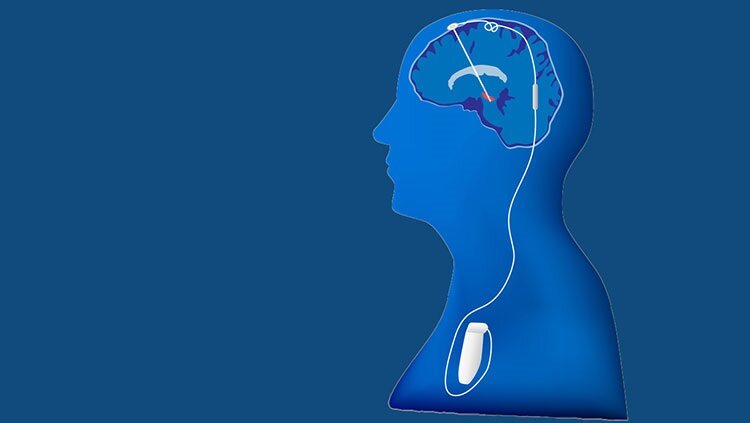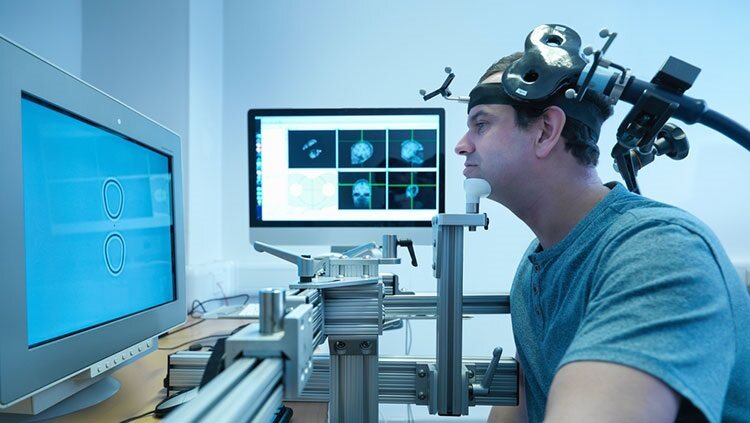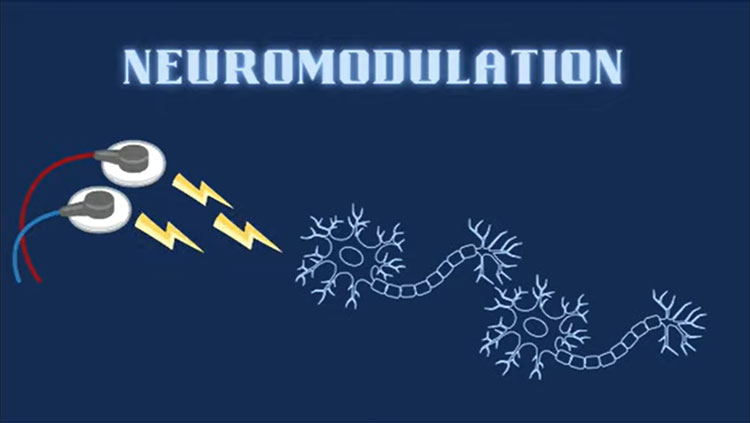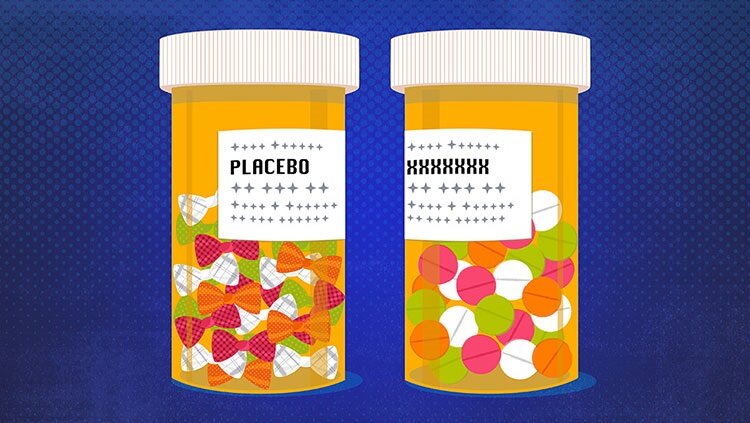Assisting Brain Activity with Deep Brain Stimulation
- Reviewed11 Sep 2023
- Author Knvul Sheikh
- Source BrainFacts/SfN

Diseases, illnesses, and other conditions can sometimes impact electrical signaling in brain networks. Insights into movement disorders have rekindled interest in the use of focused electrical stimulation in deeper brain regions as a form of treatment. The most advanced and precise method — deep brain stimulation (DBS) — was inspired by pacemakers engineered for the heart. Instead of electrodes implanted in the heart, the electrodes of the DBS device are surgically embedded in specific brain regions. Depending on where the electrodes are placed, DBS devices can help alleviate the symptoms of some brain disorders.
During most of these implantation surgeries, patients remain awake so that a neurosurgeon can talk to them and ensure that the electrodes are stimulating the correct structures. While the patient’s head is held in place with a stereotactic frame, the surgeon drills a dime-sized hole (or smaller) in the skull. Then, an electrode is inserted deep into the targeted brain structure; if both sides of the brain are to receive implants, an electrode is inserted into each side. In a separate surgery, a battery-operated pulse generator is implanted in the upper chest and connected to the electrodes. Surgical procedures may vary: People may remain asleep for the surgery; a person’s head is not always held in place with a stereotactic frame; and the DBS implant and pulse generator surgeries can sometimes be done in a single operation. When the device is turned on, it starts sending electrical currents that alter the activity of the targeted brain cells.
The implanted device relies on the fact that neuronal communication uses electrical signals. In many movement disorders, an abnormal signal or pulse can gain control of a circuit and can easily become magnified. Like someone shouting in a crowded room, this aberrant signal can drown out other activity. DBS interrupts the shouting, so that normal communication can continue within the brain network.
To determine where brain activity needs to be silenced or induced, neurosurgeons must identify the locations of the problems. The brain areas first targeted for essential tremor and Parkinson’s disease were chosen after years of painstaking neuroimaging, neuroanatomy, and fundamental research, especially in nonhuman primate models. Since then, deep brain stimulation has been used to treat epilepsy, dystonia, Tourette’s syndrome, and, more recently, obsessive-compulsive disorder. Now researchers are investigating whether the DBS technique can potentially be extended to mood disorders such as treatment-resistant depression, as well as other complex mental disorders.
Yet DBS, like any surgical procedure, is not without some risks. It is highly invasive, and potential complications include infection, stroke, and bleeding in the brain. It also requires regular neurological follow-up and battery changes every three to five years for standard devices and about every nine years for rechargeable devices. But surgical candidates are selected carefully by a team of neurosurgeons, neurologists, neuropsychologists, and speech and occupational therapists to reduce the probability of complications.
Adapted from the 8th edition of Brain Facts by Knvul Sheikh.
CONTENT PROVIDED BY
BrainFacts/SfN
References
Armitage, H. (2015). Gene-editing method halts production of brain-destroying proteins. Science. http://www.sciencemag.org/news/2015/10/gene-editing-method-halts-production-brain-destroying-proteins
Belluck, P. (2017). New Electrical Brain Stimulation Technique Shows Promise in Mice. New York Times. https://www.nytimes.com/2017/06/01/health/new-electrical-brain-stimulation-technique-shows-promise-in-mice.html
Boseley, S. (2001). Parkinson’s Miracle Cure Turns into a Catastrophe. The Guardian. https://www.theguardian.com/uk/2001/mar/13/highereducation.education
Chakrabarty, T., Ogrodniczuk, J., & Hadjipavlou, G. (2016). Predictive Neuroimaging Markers of Psychotherapy Response: A Systematic Review. Harvard Review of Psychiatry, 24(6), 396–405. https://doi.org/10.1097/HRP.0000000000000132
Costandi, M. (2015). Gene therapy rescues dying cells in the brains of Alzheimer’s patients. The Guardian. https://www.theguardian.com/science/neurophilosophy/2015/aug/28/gene-therapy-rescues-dying-cells-in-the-brains-of-alzheimers-patients
Deep Brain Stimulation for Movement Disorders. (2017). University of Pittsburgh. http://www.neurosurgery.pitt.edu/centers-excellence/epilepsy-and-movement-disorders-program/deep-brain-stimulation-movement-disorders
Deep Brain Stimulation. (2022). Cleveland Clinic. https://my.clevelandclinic.org/health/treatments/21088-deep-brain-stimulation
Deep Brain Stimulation. (2017). Mayo Clinic. http://www.mayoclinic.org/tests-procedures/deep-brain-stimulation/home/ovc-20156088
Earlier Diagnosis. (2017). Alzheimer’s Association. http://www.alz.org/research/science/earlier_alzheimers_diagnosis.asp
Fisher, E. (2014). Psychiatrists Embrace Deep-Brain Stimulation. Scientific American. https://www.scientificamerican.com/article/psychiatrists-embrace-deep-brain-stimulation/
Gay, M. (2015). Brain New World. The Scientist. http://www.the-scientist.com/?articles.view/articleNo/44079/title/Brain-New-World/
Hardesty, L. (2015). Predicting change in the Alzheimer’s brain. MIT News. Massachusetts Institute of Technology. http://news.mit.edu/2015/predicting-change-alzheimer’s-brain-1006
Kasten, F. H., & Herrmann, C. S. (2017). Transcranial Alternating Current Stimulation (tACS) Enhances Mental Rotation Performance during and after Stimulation. Frontiers in Human Neuroscience, 11, 2. https://doi.org/10.3389/fnhum.2017.00002
Mancuso, L. E., Ilieva, I. P., Hamilton, R. H. and Farah, M. J. (2016). Does Transcranial Direct Current Stimulation Improve Healthy Working Memory?: A Meta-analytic Review. Journal of Cognitive Neuroscience, 28, 8, 1063-1089. https://doi.org/10.1162/jocn_a_00956
Morishita, T., Fayad, S. M., Higuchi, Ma. Et al. (2014). Deep Brain Stimulation for Treatment-resistant Depression: Systematic Review of Clinical Outcomes. Neurotherapeutics, 11, 475–484. https://doi.org/10.1007/s13311-014-0282-1
Nutt, A. E. (2016). The Mind’s Biology. The Washington Post. https://www.washingtonpost.com/sf/national/2016/02/19/brain-hacking-the-minds-biology/
Oremus, W. (2013). Spark of Genius. Slate. http://www.slate.com/articles/technology/superman/2013/04/tdcs_and_rtms_is_brain_stimulation_safe_and_effective.html
Orenstein, D. (2012). People with paralysis control robotic arms using brain-computer interface. Brown University. https://news.brown.edu/articles/2012/05/braingate2
Piore, A. (2015). A Shocking Way to Fix the Brain. MIT Technology Review. https://www.technologyreview.com/s/542176/a-shocking-way-to-fix-the-brain/
Rotsides, J., Mammis, A. (2013). The Use of Deep Brain Stimulation in Tourette’s Syndrome. Medscape. http://www.medscape.com/viewarticle/813944
Schmidt, H. D., Shelton, R. C., & Duman, R. S. (2011). Functional biomarkers of depression: diagnosis, treatment, and pathophysiology. Neuropsychopharmacology, 36(12), 2375–2394. https://doi.org/10.1038/npp.2011.151
Scudellari, M. (2016). Gene Therapy Might Be the Best, and Perhaps Only, Chance at Curing Brain Diseases. Newsweek. http://www.newsweek.com/2016/05/06/gene-therapy-brain-disease-453217.html
She, A. (2016). CRISPR in Neuroscience: How Precision Gene Editing May Unravel How the Brain Works (and Why it Sometimes Doesn’t). SITNBoston. http://sitn.hms.harvard.edu/flash/2016/crispr-in-neuroscience-how-precision-gene-editing-may-unravel-how-the-brain-works-and-why-it-sometimes-doesn’t/
Sheikh, K. (2016). Eavesdropping on the brain. Scienceline. New York University. http://scienceline.org/2016/01/eavesdropping-on-the-brain/
Sheikh, K. (2017). Cell Therapy 2.0: Reprogramming the Brain’s Own Cells for Parkinson’s Treatment. Scientific American. https://www.scientificamerican.com/article/cell-therapy-2-0-reprogramming-the-brain-rsquo-s-own-cells-for-parkinson-rsquo-s-treatment/
Wolters Kluwer Health: Lippincott Williams and Wilkins. (2016). Brain scans could help predict response to psychotherapy for anxiety and depression. ScienceDaily. https://www.sciencedaily.com/releases/2016/11/161110115340.htm
Zeliadt, N. (2017). Brain Scans May Forecast Autism in Babies. Scientific American. https://www.scientificamerican.com/article/brain-scans-may-forecast-autism-in-babies/
What to Read Next
Also In Therapies
Trending
Popular articles on BrainFacts.org



















